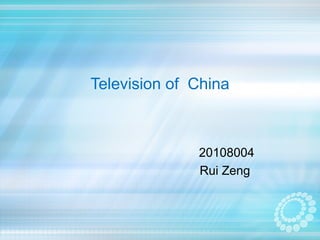
Television of china
- 1. Television of China 20108004 Rui Zeng
- 2. Directory • Introduction • History of China's TV • China today's TV • Reference
- 3. Introduction • The television industry in the People's Republic of China includes high-tech program production, transmission and coverage. China Central Television is China's largest and most powerful national television station. By the nineteen eighties two thirds of people in China had access to television while today over 3,000 channels are available in the country.
- 4. History of China's TV----Origins • When the People's Republic was founded in 1949, the telecommunications systems and facilities in China were outdated and rudimentary, and many had been damaged or destroyed during the war years. Communications in China were established rapidly in the early 1950s. By 1952 the principal telecommunications network centered on Beijing, and links to all large cities had finally been established, also launching television broadcasts. The first national broadcasts began on May, 1, 1958, and Beijing Television (now China Central Television since 1978) was formally launched on September 2, 1958. A month later would see the launch of the first regional station, Shanghai Television, on the 9th PRC National Day, October 1, 1958. Liaoning Television would • May 1, 1958China's first television production site begin a year later, and in 1960 Zhejiang and Guandong provinces had their stations begin fulll broadcasts.
- 5. History of China's TV----Origins Growth in telecommunications halted with the general economic collapse after the Great Leap Forward (1958–60) but revived in the 1960s: radio-television service was installed in major cities in these years. By 1965 there were 12 television stations in mainland China (compared to approximately 700 conventional television stations and about 3,000 cable channels today). Similarly, in 1978, there was less than one television receiver per 100 people, and fewer than ten million Chinese had access to a television set (in 2003 there were about 35 TVs for every 100 people, and roughly a billion Chinese had access to television); expansion and modernization of the broadcasting systems continued throughout the late-1970s and early 1980s.
- 6. History of China's TV----After reform and opening up The Ministry of Radio and Television was established as a separate entity in 1982 to administer and upgrade the status of television and radio broadcasting. Subordinate to this ministry were the Central People's Broadcasting Station, Radio Beijing, and China Central Television. Additionally, the various broadcasting training, talent- search, research, publishing, and manufacturing organizations were brought under the control of the Ministry of Radio and Television. In 1986 responsibility for the movie industry was transferred from the Ministry of Culture to the new Ministry of Radio, Cinema, and Television.
- 7. History of China's TV---2000s In 2001, the Chinese government put forward a goal of promoting media amalgamation by establishing trans-regional multi-media news groups. The State Administration of Radio, Film, and Television (SARFT), founded at the end of 2001,By 2003, 30 overseas television networks, including Phoenix Television, Bloomberg Television, STAR TV, Eurosport, BBC World, CNBC,
- 8. Today Altogether there are 3,000 television stations across the country. Large international TV expositions, including the Shanghai Television Festival, Beijing International Television Week, China Radio and Television Exposition and Sichuan Television Festival, are held on a regular basis. Besides judging and conferring awards, these festivals conduct academic exchange and the import and export of TV programs. Shanghai has become the largest television program trading market in Asia. Since China entered the World Trade Organization, the trend within China's media industry is to form inter-media and trans-regional media groups operated with multiple patterns so as to meet competition and challenges from powerful overseas media groups.
- 9. Reference • http://en.wikipedia.org/wiki/Television_in_the_People %27s_Republic_of_China • http://baike.baidu.com/view/125699.htm
- 10. THANK YOU